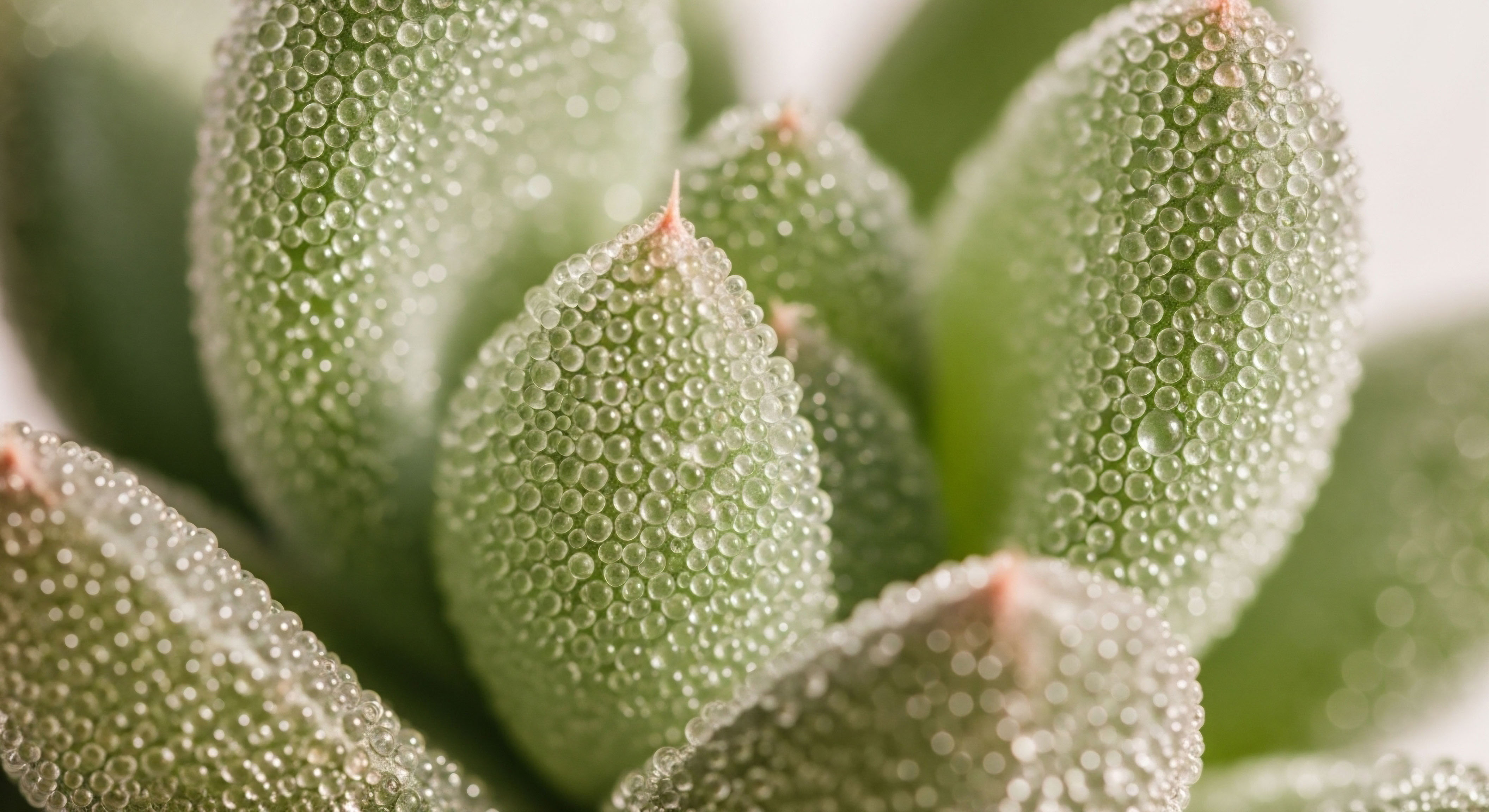

Fundamentals
When you experience a sensation of discomfort following an injection, it is a signal from your body, a direct communication from your biological systems. This feeling, whether a dull ache, a sharp sting, or a lingering tenderness, is not simply an isolated event.
It connects to the intricate network of your endocrine system and its broader influence on your metabolic function and overall vitality. Many individuals embarking on personalized wellness protocols, particularly those involving hormonal optimization, encounter these sensations. Understanding these experiences, rather than dismissing them, becomes a foundational step in reclaiming your well-being.
Your body operates through a sophisticated internal messaging service, where chemical messengers, known as hormones, orchestrate countless physiological processes. These substances regulate everything from your energy levels and mood to your body composition and reproductive capacity. When these internal communications become imbalanced, symptoms can arise, leading many to seek interventions such as targeted hormonal support.
Understanding post-injection sensations provides insight into your body’s intricate communication systems and its response to external interventions.
Administering these vital biochemical recalibrations often involves injections. This method ensures precise delivery and optimal absorption, particularly for compounds that might degrade in the digestive system or require a sustained release into the bloodstream. The choice of injection method, whether into muscle tissue or beneath the skin, directly influences how these compounds enter your circulation and interact with your body’s cellular machinery.
Consider the basic anatomy involved in any injection. Your skin, a protective barrier, consists of multiple layers ∞ the outer epidermis, the deeper dermis containing nerve endings and blood vessels, and the underlying subcutaneous tissue, which is rich in fat cells. Beneath these layers lie your muscles. Each of these tissues possesses a unique density of nerve fibers and blood supply, which inherently affects the sensation experienced during and after needle penetration.
Initial discomfort following an injection stems from several immediate factors. The physical act of the needle piercing the skin and underlying tissues creates a localized mechanical disruption. This mechanical stimulus activates sensory nerve endings, transmitting signals to your brain that are interpreted as pain or pressure.
The volume of the injected substance, its temperature, and its chemical properties also contribute to the immediate tissue response. A larger volume can distend tissue, while a solution that is too cold or too acidic might irritate local cells.
Why does the same injection sometimes feel different? Individual variations in pain thresholds, tissue density, and even hydration status can alter the subjective experience. One person might report minimal sensation, while another describes significant tenderness from an identical procedure. This variability underscores the deeply personal nature of physiological responses and the importance of a personalized approach to wellness protocols.

What Factors Influence Immediate Injection Sensation?
The sensation experienced at the moment of injection is a complex interplay of physical and physiological elements. The sharpness and diameter of the needle, known as its gauge, play a primary role. A finer needle generally causes less initial trauma to the skin and nerve endings. The speed at which the needle enters the tissue also matters; a swift, confident insertion can minimize the duration of the mechanical stimulus.
Beyond the needle itself, the characteristics of the injected solution contribute significantly. The viscosity of the fluid, its thickness, determines how easily it flows through the needle and disperses within the tissue. Thicker solutions require more pressure to inject, potentially causing greater tissue distension. The pH of the solution, its acidity or alkalinity, can also irritate local nerve endings if it deviates significantly from the body’s physiological pH.
Moreover, the presence of certain excipients or preservatives within the medication can sometimes elicit a localized reaction. While these components are necessary for drug stability and sterility, they can occasionally trigger a mild inflammatory response at the injection site, contributing to immediate or delayed discomfort. Understanding these basic principles sets the stage for a deeper exploration of how precise technique can mitigate these sensations.


Intermediate
Transitioning from foundational concepts, we now consider the specific clinical protocols that leverage injection techniques for optimizing hormonal balance and metabolic function. These protocols, whether involving testosterone replacement therapy or growth hormone peptides, rely on precise administration to achieve their therapeutic goals while minimizing post-injection discomfort. The ‘how’ and ‘why’ of these therapies are deeply intertwined with the method of delivery.
For men experiencing symptoms of low testosterone, Testosterone Replacement Therapy (TRT) often involves weekly intramuscular injections of Testosterone Cypionate. This specific formulation is designed for slow release, providing a steady supply of the hormone over several days. Alongside this, Gonadorelin, a peptide that stimulates natural testosterone production, is typically administered via subcutaneous injections twice weekly. This dual approach addresses both direct hormone replacement and the preservation of endogenous endocrine function.
Women seeking hormonal balance, particularly during peri-menopause and post-menopause, also benefit from targeted protocols. Low-dose Testosterone Cypionate, typically 0.1-0.2 ml weekly, is administered subcutaneously. Progesterone, a vital hormone for female endocrine health, is prescribed based on individual needs. Some women also opt for pellet therapy, where long-acting testosterone pellets are inserted subcutaneously, offering a sustained release over several months.
Precise injection technique is paramount for optimizing therapeutic outcomes and minimizing discomfort across diverse hormonal protocols.
Growth hormone peptide therapy, sought by active adults for anti-aging benefits, muscle gain, and improved sleep, also relies on subcutaneous injections. Peptides such as Sermorelin, Ipamorelin, CJC-1295, Tesamorelin, and Hexarelin are administered this way. These smaller protein fragments act as signaling molecules, influencing various physiological processes. The precise delivery ensures their bioavailability and targeted action within the body’s complex communication systems.

Optimizing Needle Characteristics for Comfort
The choice of needle gauge and length significantly influences the mechanical impact on tissues. A higher gauge number indicates a finer needle. For subcutaneous injections, common gauges range from 27 to 31 gauge, with lengths typically between 4mm and 12.7mm. These fine, short needles minimize trauma to the superficial nerve endings in the skin.
For intramuscular injections, where deeper penetration is required, gauges typically range from 21 to 25 gauge, with lengths from 1 inch to 1.5 inches, depending on the muscle and patient body composition. Selecting the appropriate needle ensures the medication reaches the intended tissue layer without unnecessary discomfort.
Consider the specific injection site. For intramuscular injections, the ventrogluteal site (upper outer quadrant of the buttock), the deltoid muscle (upper arm), and the vastus lateralis (outer thigh) are common choices. These sites are selected for their muscle mass and distance from major nerves and blood vessels.
Subcutaneous injections are typically administered into the fatty tissue of the abdomen (at least two inches from the navel), the outer thigh, or the back of the upper arm. These areas offer sufficient subcutaneous fat and are generally less sensitive.
How Does Site Selection Impact Injection Discomfort?

Procedural Steps for Reduced Sensation
Careful preparation of the injection site is a fundamental step in minimizing discomfort. Cleansing the skin with an alcohol swab removes surface bacteria, reducing the risk of infection. Allowing the alcohol to dry completely before injection prevents a stinging sensation. Some individuals find that warming the medication to body temperature, by holding the vial or syringe in their hand for a few minutes, can reduce the local sensation of cold fluid entering the tissue.
The speed of needle insertion and plunger depression also plays a critical role. A swift, confident insertion through the skin minimizes the duration of the initial sharp sensation. Once the needle is in place, depressing the plunger slowly and steadily allows the medication to disperse gradually within the tissue, reducing pressure and distension. Rapid injection can create a bolus effect, leading to localized pressure and discomfort.
Post-injection care contributes to reducing lingering discomfort. Applying gentle pressure to the site with a sterile gauze pad immediately after needle withdrawal can help prevent bruising and minor bleeding. Some individuals find that applying a cold pack to the area for a few minutes can help numb the site and reduce swelling, while others prefer a warm compress to promote dispersion of the medication and improve circulation.
What Post-Injection Care Strategies Minimize Tenderness?
| Characteristic | Intramuscular (IM) | Subcutaneous (SubQ) |
|---|---|---|
| Target Tissue | Muscle layer | Fatty tissue beneath skin |
| Needle Gauge | 21-25 gauge | 27-31 gauge |
| Needle Length | 1-1.5 inches | 4mm-12.7mm |
| Absorption Rate | Rapid to moderate | Slower, sustained |
| Volume Capacity | Up to 3-5 ml (site dependent) | Up to 1-2 ml |
| Common Medications | Testosterone Cypionate, certain vaccines | Gonadorelin, Growth Hormone Peptides, Insulin |
Proper technique extends beyond the physical act of injection. It encompasses understanding the medication’s properties, selecting the optimal site, and providing appropriate post-procedure care. These elements collectively contribute to a more comfortable and effective therapeutic experience, allowing individuals to adhere to their personalized wellness protocols with greater ease.
- Needle Selection ∞ Choose the finest gauge and shortest length appropriate for the medication and injection type.
- Site Preparation ∞ Cleanse the skin thoroughly with alcohol and allow it to dry completely.
- Medication Temperature ∞ Allow refrigerated medications to reach room temperature before administration.
- Insertion Technique ∞ Insert the needle swiftly and confidently at the correct angle for the chosen site.
- Injection Speed ∞ Depress the plunger slowly and steadily to allow gradual dispersion of the fluid.
- Post-Injection Pressure ∞ Apply gentle, sustained pressure to the site after needle withdrawal.


Academic
Moving into a deeper scientific exploration, the influence of injection technique on post-injection discomfort extends beyond mere mechanical factors to encompass complex physiological and biochemical responses. This academic perspective delves into the pharmacokinetics and pharmacodynamics of injected substances, the cellular microenvironment, and the intricate pathways of pain signaling, all viewed through the lens of a systems-biology approach. Understanding these underlying mechanisms provides a comprehensive appreciation for the precision required in hormonal optimization protocols.
The way a substance is injected directly alters its pharmacokinetics, which describes how the body handles the medication ∞ its absorption, distribution, metabolism, and excretion. For intramuscular injections, the rich vascularity of muscle tissue facilitates relatively rapid absorption into the systemic circulation.
However, if the injection is too superficial or too deep, or if the muscle is tensed, absorption can be inconsistent, leading to suboptimal therapeutic levels and potentially localized pooling of the medication, which can cause prolonged discomfort. Subcutaneous injections, by contrast, rely on diffusion through the fatty tissue into the capillaries, resulting in a slower, more sustained absorption profile.
Improper technique, such as injecting into dense fibrous tissue or too close to a major vessel, can disrupt this intended absorption pattern.
Beyond pharmacokinetics, the local tissue reaction is governed by pharmacodynamics, the study of how the drug affects the body. The physical trauma of needle insertion and the chemical properties of the injected solution initiate a localized biological response. This response involves the activation of various cell types and the release of signaling molecules within the tissue microenvironment.
Injection technique profoundly influences the pharmacokinetic profile and local tissue response, impacting both therapeutic efficacy and patient comfort.

Tissue Microenvironment and Inflammatory Pathways
When a needle penetrates tissue, it causes mechanical damage to cells and capillaries. This damage triggers an immediate inflammatory cascade. Localized cells, including mast cells and damaged tissue cells, release pro-inflammatory mediators such as histamine, bradykinin, and prostaglandins. These substances increase vascular permeability, leading to localized swelling (edema) and redness (erythema). They also directly sensitize and activate local nociceptors, which are specialized sensory nerve endings responsible for transmitting pain signals.
The volume and osmolarity of the injected fluid also play a significant role. Injecting a large volume into a confined space, particularly in subcutaneous tissue, can create significant pressure, distending the tissue and mechanically activating nociceptors. Solutions that are hypertonic or hypotonic relative to physiological fluids can cause osmotic shifts in cells, leading to cellular irritation and contributing to discomfort.
The pH of the solution, if significantly acidic or alkaline, can directly damage cell membranes and activate acid-sensing ion channels on nerve endings, eliciting a burning sensation.
How Do Cellular Responses Contribute to Post-Injection Pain?

Nerve Distribution and Pain Perception
The density and distribution of nerve endings vary across different injection sites. Areas like the abdomen and deltoid, commonly used for subcutaneous and intramuscular injections respectively, have a relatively lower density of pain receptors compared to other regions. However, even within these sites, individual variations exist.
Accidental contact with a nerve bundle, even a small one, can result in a sharp, radiating pain that is disproportionate to the overall tissue trauma. This underscores the importance of careful site selection and proper anatomical landmarks.
Pain perception is not solely a peripheral phenomenon; it is modulated by the central nervous system. Factors such as anxiety, previous negative experiences, and individual psychological states can amplify the perception of pain. This psychoneuroimmunological interplay means that a patient’s mental state can influence the intensity and duration of post-injection discomfort, even when the physical technique is flawless. Empathetic communication and reassurance from the administering clinician can therefore play a role in mitigating perceived discomfort.
| Factor | Mechanism of Influence | Impact on Discomfort |
|---|---|---|
| Needle Gauge & Length | Mechanical tissue trauma, depth of penetration | Finer needles reduce initial pain; incorrect length can cause pooling or nerve contact |
| Injection Site Selection | Nerve density, muscle mass, vascularity | Sites with fewer nerves and adequate tissue reduce pain and bruising |
| Fluid Volume & Viscosity | Tissue distension, ease of dispersion | Larger volumes or thicker fluids increase pressure and localized ache |
| Solution pH & Osmolarity | Cellular irritation, nerve activation | Non-physiological pH/osmolarity can cause burning or stinging |
| Injection Speed | Rate of tissue distension, duration of mechanical stimulus | Rapid injection increases immediate pressure and pain |
| Sterility & Contamination | Introduction of pathogens, localized infection | Infection leads to inflammation, swelling, heat, and severe pain |
| Patient Anxiety | Central nervous system modulation of pain pathways | Increased anxiety can heighten pain perception |

Sterile Technique and Infection Risk
A critical, yet often overlooked, aspect influencing post-injection discomfort is the adherence to strict sterile technique. The skin harbors a diverse microbiome, and improper cleansing or handling of equipment can introduce bacteria into the injection site. While minor discomfort might stem from the injection itself, a localized infection can lead to significantly increased pain, redness, swelling, warmth, and even systemic symptoms.
This involves a more aggressive inflammatory response, with immune cells migrating to the site to combat the invading pathogens, leading to prolonged and intensified discomfort.
Long-term hormonal protocols, such as those involving weekly or bi-weekly injections, necessitate consistent attention to technique to prevent chronic tissue changes. Repeated injections into the exact same spot can lead to lipodystrophy (changes in fat tissue, either atrophy or hypertrophy) or localized scarring.
These tissue alterations can not only affect the absorption of subsequent injections but also increase the likelihood of discomfort due to altered tissue compliance and nerve sensitivity. Rotating injection sites systematically is a simple yet effective strategy to mitigate these long-term effects and maintain tissue health.
The scientific understanding of injection technique extends beyond simple procedural steps. It encompasses a deep appreciation for the body’s physiological responses at the cellular and systemic levels. By integrating knowledge of pharmacokinetics, inflammatory pathways, neurobiology, and sterile principles, clinicians and individuals can optimize injection practices to enhance both therapeutic outcomes and the overall experience of personalized wellness protocols. This meticulous approach ensures that the journey toward hormonal balance is as comfortable and effective as possible.

References
- Guyton, Arthur C. and John E. Hall. Textbook of Medical Physiology. 14th ed. Elsevier, 2020.
- Boron, Walter F. and Emile L. Boulpaep. Medical Physiology. 3rd ed. Elsevier, 2017.
- Endocrine Society. Clinical Practice Guideline ∞ Testosterone Therapy in Men with Hypogonadism. Journal of Clinical Endocrinology & Metabolism, 2018.
- Endocrine Society. Clinical Practice Guideline ∞ Treatment of Symptoms of the Menopause. Journal of Clinical Endocrinology & Metabolism, 2015.
- Katzung, Bertram G. Anthony J. Trevor, and Susan B. Masters. Basic & Clinical Pharmacology. 15th ed. McGraw-Hill Education, 2021.
- Dunn, Cynthia, and Mary E. Miller. “Injection Site Pain ∞ A Review of Contributing Factors and Strategies for Prevention.” Journal of Infusion Nursing, vol. 39, no. 4, 2016, pp. 240-247.
- Pichard, David C. and Andrew M. J. M. van Eijk. “Needle-Related Pain and Anxiety in Adults ∞ A Review of Causes and Solutions.” Pain Management Nursing, vol. 17, no. 2, 2016, pp. 131-140.
- Hussain, Muhammad A. and David A. G. B. Smith. “Pharmacokinetics of Testosterone Preparations.” Clinical Pharmacokinetics, vol. 55, no. 10, 2016, pp. 1199-1212.
- Chrousos, George P. “The Hypothalamic-Pituitary-Adrenal Axis and Immune-Mediated Inflammation.” New England Journal of Medicine, vol. 332, no. 20, 1995, pp. 1351-1362.
- Melzack, Ronald, and Patrick D. Wall. The Challenge of Pain. 2nd ed. Penguin Books, 1980.

Reflection
As you consider the detailed mechanisms behind injection technique and its influence on post-injection discomfort, reflect on your own biological systems. This knowledge is not merely academic; it is a tool for self-understanding and empowerment. Recognizing the intricate interplay of hormones, tissues, and neural pathways transforms a simple injection into a window into your body’s remarkable adaptive capacity.
Your personal health journey is unique, shaped by your individual physiology and experiences. The insights gained here represent a foundational step, providing clarity on how precise actions can yield significant improvements in comfort and therapeutic efficacy. This understanding empowers you to engage more actively in your wellness protocols, asking informed questions and advocating for practices that align with your body’s needs.
Reclaiming vitality and optimal function without compromise is a deeply personal endeavor. It requires a commitment to understanding your own biological systems and collaborating with knowledgeable professionals. This exploration of injection technique serves as a reminder that even seemingly minor details hold significant implications for your overall well-being. Continue to seek knowledge, for it is through understanding that true health optimization becomes possible.



